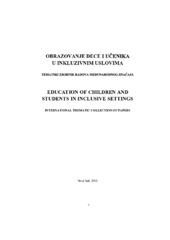Приказ основних података о документу
Teškoća u pisanju kao determinanta brzine pisanja
Handwriting difficulty as a determinant of writing speed
| dc.creator | Vujanović, Marina | |
| dc.creator | Ilić-Stošović, Danijela | |
| dc.date.accessioned | 2022-07-20T10:58:30Z | |
| dc.date.available | 2022-07-20T10:58:30Z | |
| dc.date.issued | 2018 | |
| dc.identifier.isbn | 978-86-80326-07-8 | |
| dc.identifier.uri | http://rfasper.fasper.bg.ac.rs/handle/123456789/4708 | |
| dc.description.abstract | Pisanje predstavlja veštinu veoma važnu u razvoju svakog pojedinca, a brzina pisanja jeste veoma značajna za vaspitno-obrazovni proces učenika. Kako bi se ispitala brzina pisanja učenika nižih razreda osnovne škole i prikazale razlike u brzini pisanja učenika sa i bez teškoća u pisanju, tokom 2016. godine sprovedeno je istraživanje u Beogradu, na uzorku od 1156 učenika nižih razreda osnovne škole. Brzina pisanja posmatrana je kroz postignuća na četiri zadatka pisanja, a prosečna brzina pisanja je najviša u zadatku pisanja napamet (40,86 slova po minuti), a najmanja onda kada se tekst prepisuje s veće razdaljine (36,31). Neadekvatna brzina pisanja, ukoliko se posmatra prosečna brzina na sva četiri zadatka, javlja se kod 78 (6,7%) učenika, dok su teškoće u pisanju, posmatrane kroz brzinu pisanja i čitljivost rukopisa prisutne kod 10,2% učenika. Najveći broj učenika sa teškoćama u pisanju pohađa prvi razred (12,2%), a najmanji broj učenika sa teškoćama u pisanju pohađa treći razred (8,5%), međutim, oni su ravnomerno raspoređeni po razredima (χ(2)= 2,13, p= ,546). Učenici bez teškoća u pisanju ostvaruju veću brzinu u izvršavanju svih zadataka i ukupno od učenika kod kojih su konstatovane teškoće u pisanju, a ova razlika je i statistički značajna (p= ,000). Kvalitet pisanja učenika nižih razreda osnovne škole jeste jedan od pokazatelja njihove uspešnosti u vaspitno-obrazovnom procesu, a brzina pisanja jeste pokazatelja koji može ukazivati na postojanje teškoća u pisanju. S obzirom na to da dobijeni rezultati pokazuju da se učenici sa teškoćama u pisanju u mnogo većem broju susreću sa problemima brzine pisanja, nameće se potreba za prilagođavanjem vaspitno-obrzovnog procesa sposobnostima i potrebema učenika, kroz mere individualizacije ili izradu individualnog obrazovnog plana, uz angažovanje defektologa kao člana stručnog tima škole. | sr |
| dc.description.abstract | Writing is a skill that is very important in the development of each individual, and writing speed is very important for the educational process of students. In order to examine the speed of writing students of lower grades of elementary school, and to show differences in the speed of writing students with and without difficulty in writing, a survey in Belgrade was conducted in 2016 on a sample of 1156 pupils of lower grades of elementary school. The speed of writing is viewed through the achievements of the four writing tasks, and the average writing speed is the highest in the writing task at a memory (40.86 letters per minute), and the smallest when the text is copied from a greater distance (36.31). Inadequate writing speed, if the average speed is observed for all four tasks, occurs in 78 (6.7%) of students, while the writing difficulties observed through the writing speed and the legibility of the manuscript are present in 10.2% of the students. The highest number of students with writing difficulties attend the first grade (12.2%), while the smallest number of students with difficulty in writing attend the third grade (8.5%), however, they are equally scattered by classes (χ (2)= 2.13, p= .546). Students with no difficulty in writing accomplish higher speed in performing all tasks, and in total from pupils with writing difficulties, and this difference is also statistically significant (p = .000). The quality of writing students of lower grades of elementary school is one of the indicators of their success in the educational process, and the speed of writing is an indicator that can indicate the existence of writing difficulty. Given that the obtained results show that students with writing difficulties are more likely to meet the problems of writing speed, will be imposed the need for adapting the educational process to the student's abilities, through the measures of individualization or the development of an individual education plan, with the engagement of a special educator as a member of the professional team of the schoo | sr |
| dc.language.iso | sr | sr |
| dc.publisher | Društvo defektologa Vojvodine | sr |
| dc.rights | openAccess | sr |
| dc.rights.uri | https://creativecommons.org/licenses/by-sa/4.0/ | |
| dc.source | Obrazovanje dece i učenika u inkluzivnim uslovima Tematski zbornik radova međunarodnog značaja | sr |
| dc.subject | brzina pisanja | sr |
| dc.subject | defektolog | sr |
| dc.subject | individualni obrazovni plan | sr |
| dc.subject | mere individaulaizacije | sr |
| dc.subject | teškoće u pisanju | sr |
| dc.subject | individual educational plan | sr |
| dc.subject | individualization measures | sr |
| dc.subject | special educator | sr |
| dc.subject | writing difficulties | sr |
| dc.subject | writing speed | sr |
| dc.title | Teškoća u pisanju kao determinanta brzine pisanja | sr |
| dc.title | Handwriting difficulty as a determinant of writing speed | sr |
| dc.type | conferenceObject | sr |
| dc.rights.license | BY-SA | sr |
| dc.citation.epage | 68 | |
| dc.citation.spage | 56 | |
| dc.identifier.fulltext | http://rfasper.fasper.bg.ac.rs/bitstream/id/8611/dsha.pdf | |
| dc.identifier.rcub | https://hdl.handle.net/21.15107/rcub_rfasper_4708 | |
| dc.type.version | publishedVersion | sr |


